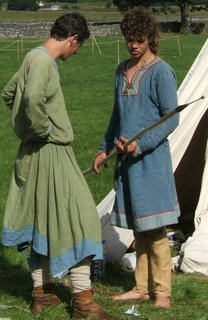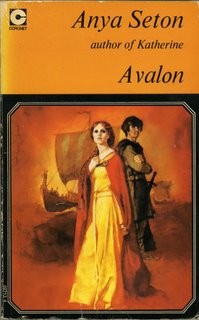
This is just a drop by to say I haven't vanished off the face of the earth. I've been busy working on the new novel about John Marshal, provisional title Hammers And Anvils - although that might change when it comes to publication. It's going well but since it's my job, I have to keep up the word count. I've taken a couple of days off for various things, such as Regia at Castleton, seeing my agent and dealing with the usual domestic detritus. I've also been preparing some new material for my website which will be up shortly. http://www.elizabethchadwick.com
Next Thursday, I've been asked to give a talk at Ottakers in Loughborough. I'll be around from 6.30pm onwards, so if anyone's in the vicinity and wants to say hello, do drop by. I'm hoping to bring my sword and helm with me, also my piece of mail - part of a ventail belonging to one of Regia's craftsmen/warriors. In the meantime, here's a snip from the most recent remote viewing session, done on Tuesday with my agent present as an observer. For the context of what this involves, see my earlier blog post on this subject. http://livingthehistoryelizabethchadwick.blogspot.com/2006/04/remote-control.html
I know John Marshal and his father fought a duel over the Marshalsea. Checking my notes, I see it was against William de Hastings and Robert de Venoiz. De Venoiz’s father had once been a Marshal – Geoffrey the Marshal. Dare one think noses had been put out of joint?
My Friend: Puffing and panting in panic or exertion. I’m with the father. It’s a big thing for a man of his age to do. He’s pleased his son is a healthy young man. All the lessons, all the training have been worthwhile. He’s got a helmet on and he’s looking around. There are rows of people watching and a fence in front of them. He’s taking a mouthful of liquid – it’s water – and just spitting it out. John is there. He’s a lot cooler than his father about this. He knows he has to protect his father and keep his father behind him. The other people have got a different sort of armour on. It’s burnished and bronzey while John’s and his father’s is that blackened silver colour. I’m with John now. He’s sizing up the field and his tactics. He thinks he’ll go for the older man, head him off and finish him quickly because he’s the better fighter, and then he can run round and get the younger man. If the younger man goes for his father, his father’s bulk will be able to hold him off until John can get to him. John acts as if he’s still nonchalantly taking a break, but then he suddenly turns round and with a roar, attacks. The other two are taken by surprise by the swiftness of John’s assault. They think he’s going for the younger man, but he crosses over in front of the older one. He’s using a morning star flail in one hand and a dagger in the other – he’s going all or nothing for this. If he’s going to protect his father he’s got to fight for two of them. He’s using the morning star and he’s wrapped the chain round the older man’s neck. It’s not a killing blow, but it’s enough to bring him down, choking him and wounding his neck. He might not be dead but he’s out of the fight. The younger one has been stopped in his tracks by what John’s done and the sight of the older, better fighter down. It’s what John wanted. Now John gets out his sword and challenges the younger man. The younger man is swallowing after what he’s just seen. He’s a bit reluctant to take on John. He wanted the easier job of John’s dad. He has to face John….and he’s not doing it. He’s put his sword down – yes, he’s put his sword down. John is saying ‘Come on then, you coward, come on. He pokes him with his own sword. The other won’t rise to the challenge. The wounded man is being carried off the battlefield – it looks like a horse schooling field. The young man looks at all of this, seeing the odds. He keeps his sword down. The crowd are a bit disappointed. They’re shouting ‘Go on!’
John is so contemptuous that he turns half a shoulder to the other man and then fully turns his back just to show utter contempt. Then he suddenly whips round and shakes the blade at the other man in threat. This makes the challenger look even more stupid and the crowd starts laughing. John goes up to his father, puts his arm round him and they walk off the field to cheers, their position in the Marshalsea confirmed in public.
Stirring stuff eh?






